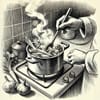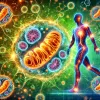Welcome back to our regular feature where we sift through thousands of new, health-related papers, and pick a few to summarize in a practical and not anxiety-inducing way.
Our main questions on each paper:
- In simple language, what does it say?
- Does it have good evidence?
- Should what it says matter to normal people?
- What simple thing, if anything, could a normal person do to take advantage of this finding?
Okay, away we go. And, as always, we rate each paper for practicality and level of interest.
This edition's papers:
- The intensity paradox: A systematic review and meta‐analysis of its impact on the cardiorespiratory fitness of older adults - Scandinavian Journal of Medicine & Science in Sports https://onlinelibrary.wiley.com/doi/10.1111/sms.14573
- The genetics of adipose tissue metabolism | Royal Society Open Science https://royalsocietypublishing.org/doi/full/10.1098/rsos.231478?af=R
- One-leg standing time is a simple measure for loss of skeletal muscle mass and fat deposition in muscle: the J-SHIPP study | Aging Clinical and Experimental Research https://link.springer.com/article/10.1007/s40520-023-02665-8
- An Exercise-Induced Metabolic Shield in Distant Organs Blocks Cancer Progression and Metastatic Disseminatiom https://www.ncbi.nlm.nih.gov/pmc/articles/PMC9762351/pdf/4164.pdf
Paper 1: Effect of Exercise Intensity
Practicality (5/5): 🏃♂️🏃♂️🏃♂️🏃♂️🏃♂️
Interest (4/5): 🏃♂️🏃♂️🏃♂️🏃♂️
Summary
We know that older adults can improve their heart and lung fitness by consistently engaging in moderate or high-intensity aerobic exercises. There is controversy about whether they should skew more to moderate vs high intensity. This paper shows they yield similar health benefits, challenging the idea that high-intensity workouts are superior.
What is the paper's main claim?
- Regular aerobic exercise, regardless of intensity, can significantly benefit older adults' heart and lung fitness.
Are the methods and/or data it uses appropriate and convincing?
- Yes, the study uses systematic review and meta-analysis to comprehensively compare moderate versus high-intensity exercises.
What do we know now that we didn't know before, if anything?
- Moderate-intensity exercises are just as effective as high-intensity exercises for improving cardiorespiratory fitness when matched for total exercise volume.
What simple and practical thing could a normal person do knowing this?
- Engage in aerobic exercises at a preferred intensity that maintains consistency and avoids injury
Paper 2: Exercise Fights Cancer
Practicality (4/5): 🏃♂️🏃♂️🏃♂️🏃♂️
Interest (4/5): 🏃♂️🏃♂️🏃♂️🏃♂️
Summary
Regular high-intensity exercise creates a "metabolic shield" in the body that can prevent cancer cells from thriving and spreading. This shield comes from increased energy demand in muscles and other organs, making it tougher for cancer cells to get the nutrients they need. Research in humans and mice supports this protective effect, particularly against highly metastatic cancers.
What is the paper's main claim?
- High-intensity physical activity can significantly reduce cancer progression and the risk of metastatic cancer.
Are the methods and/or data it uses appropriate and convincing?
- Yes, the research combines data from proteomic analyses, mouse models, and long-term human studies, providing a strong multi-faceted argument.
What do we know now that we didn't know before, if anything?
- We have a clearer understanding that the body's metabolic response to intense exercise can act as a barrier against cancer cell colonization and metastasis.
What simple and practical thing could a normal person do knowing this?
- Engage in regular, high-intensity exercise as part of a healthy lifestyle to potentially lower cancer risk.
Paper 3: Obesity Genetics Insights
Practicality (5/5): 🏃♂️🏃♂️🏃♂️🏃♂️
Interest (4/5): 🏃♂️🏃♂️🏃♂️🏃♂️
Summary
Our genes influence body fat distribution and its health risks. Some fats are more harmful than others. With the use of modern technology like MRI, researchers can better study how individual genetic differences contribute to where our bodies store fat, which in turn affects our risk for certain diseases.
What is the paper's main claim?
- Genetics play a significant role in determining how our bodies distribute fat, impacting our health risks for diseases like diabetes and heart disease.
Are the methods and/or data it uses appropriate and convincing?
- Yes, the paper replies on MRI and large-scale genetic studies to understand how different fat deposits in the body contribute to overall health.
What do we know now that we didn't know before, if anything?
- We now know that certain genetic factors are largely responsible for how fat is distributed across different parts of the body, and this distribution is a more accurate indicator of health risks than overall weight or BMI.
What simple and practical thing could a normal person do knowing this?
- Individuals might focus on waist-to-hip ratios as an indicator of health risk, rather than just looking at overall weight or BMI, and share concerns with healthcare providers for personalized advice.
Paper 4: One-Leg Standing
Practicality (4/5): 🏃♂️🏃♂️🏃♂️🏃♂️
Interest (4/5): 🏃♂️🏃♂️🏃♂️🏃♂️
Summary
The study investigated how by standing on one leg adults can learn about their muscle quantity and fat in muscles. Results indicated that those who had a hard time standing on one leg for at least 20 seconds also tended to have less muscle mass and more fat within their muscles. The research suggests that one-leg standing time could be a useful, simple test to measure muscle health in older adults.
What is the paper's main claim?
- The ability to stand on one leg is tied to muscle mass and the quality of muscles in older adults.
Are the methods and/or data it uses appropriate and convincing?
- The study used CT scans and balance tests, which are reliable and convincing methods to assess muscle characteristics.
What do we know now that we didn't know before, if anything?
- One-leg standing time (OLST) is closely associated with muscle mass and fat deposition in muscle.
What simple and practical thing could a normal person do knowing this?
- Older adults could use the one-leg standing test as a quick check of muscle health and consider consulting a healthcare professional if they struggle with the test.
We will be back with more papers next week. And if you see a paper that is getting attention, and you wonder if you should care, let us know.





